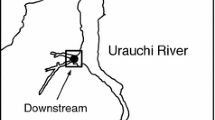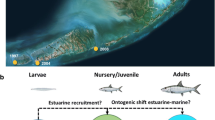Synopsis
The blind cavefish, Milyeringa veritas, inhabits an anchialine system, effectively a groundwater estuary, in which salinity varies between fresh and seawater at different locations and depths. Owing to the inaccessible habitat and the threatened status of the cavefish it is hard to obtain the biological information needed for their management. This paper explores the utility of otolith Sr:Ca ratio in elucidating cavefish biology. The mean Sr:Ca ratio of the water inhabited by the cavefish is correlated with both the TDS (total dissolved solids) of the habitat and with the Sr:Ca ratio of the sagittal otolith of the cavefish inhabiting that site. Mean values of Sr:Ca in otoliths suggest some cavefish inhabit sea or brackish waters while others remain in freshwater. Some individuals appear to move between waters of very different TDS at various stages but there is no consistency in the direction or apparent TDS range of the water bodies inhabited which indicates that the cavefish utilise the different water bodies opportunistically. Residual analyses indicate clear and routine changes in the TDS of the water occupied at various phases of growth, irrespective of the TDS at which the cavefish were sampled. Annular markings are present in some otoliths but they cannot be related to likely periodicities in the subterranean environment.
Similar content being viewed by others
References
M. Adams W.F. Humphreys (1993) ArticleTitlePatterns of genetic diversity within selected subterranean fauna of the Cape Range peninsula, Western Australia: Systematic and biogeographic implications Rec. West. Aust. Mus. Suppl. 45 145–164
American Public Health Association. 1998. Standard Methods for the Examination of Water and Wastewater, 20th edition. American Public Health Association, American Water Works Association and Water Pollution Control Federation. 1220 pp
G.E. Bath S.R. Thorrold C.M. Jones S.E. Campana J.W. McLaren J.W.H. Lam (2000) ArticleTitleStrontium and barium uptake in aragonitic otoliths of marine fish Geochim. Cosmochim. Acta 64 1705–1714 Occurrence Handle1:CAS:528:DC%2BD3cXjt1Sisrw%3D Occurrence Handle10.1016/S0016-7037(99)00419-6
I.A.E. Bayly (1986) Aspects of diel vertical migration in zooplankton, and its Enigma Variations P. Deckker ParticleDe W.D. Williams (Eds) Limnology in Australia CSIRO Australia & Dr W. Junk Publishers Dordrecht 349–368
G. Beaugrand F. Ibañez PC. Reid (2000) ArticleTitleSpatial, seasonal and long-term fluctuations of plankton in relation to hydroclimatic features in the English Channel, Celtic Sea and Bay of Biscay Mar. Ecol. Prog. Ser. 200 93–102
A.J. Boulton M.A. Brock (1999) Australian Freshwater Ecology: Processes and Management Gleneagles Publishing Glen Osmond, South Australia 300
S.E. Campana (1999) ArticleTitleChemistry and composition of fish otoliths: Pathways, mechanisms and applications Mar. Ecol. Prog. Ser. 188 263–297 Occurrence Handle1:CAS:528:DC%2BD3cXjtFKmtA%3D%3D
Casselman, J.M. 1982. Chemical analyses of the optically different zones in eel otoliths. 74 – 82. In: K.H. Loftus (ed.), Proceedings of the 1980 North American Eel Conference. Ontario Fisheries Technical Report No. 4
P.W. Cheng W.N. Tzeng (1996) ArticleTitleTiming of metamorphosis and estuarine arrival across the dispersal range of the Japanese eel Anguilla japonica Mar. Ecol. Prog. Ser. 131 87–96
A.R. Chivas P. Deckker ParticleDe J.M.G. Shelley (1985) ArticleTitleStrontium content of ostracods indicates lacustrine palaeosalinity Nature, Lond. 316 251–253 Occurrence Handle1:CAS:528:DyaL2MXkvVOitr0%3D Occurrence Handle10.1038/316251a0
G.E. Fenton S.A. Short (1992) ArticleTitleFish age validation by radiometric analysis of otoliths Aust. J. Mar. Freshwater Res. 43 913–922 Occurrence Handle1:CAS:528:DyaK3sXlsFGgs7g%3D Occurrence Handle10.1071/MF9920913
W.M. Hamner R.W. Gilmer P.P. Hamner (1982) ArticleTitleThe physical, chemical and biological characteristics of a stratified, saline, sulphide lake in Palau Limnol. Oceanogr. 27 896–909 Occurrence Handle1:CAS:528:DyaL38XlvVOrs70%3D Occurrence Handle10.4319/lo.1982.27.5.0896
W.F. Humphreys (1990) ArticleTitleThe biology of a troglobitic schizomid (Chelicerata: Arachnida) from caves in the semi-arid Cape Range, Western Australia Acta zool. Fenn. 190 181–186
Humphreys, W.F. 1994. The subterranean fauna of the Cape Range coastal plain, northwestern Australia. Report to the Australian Heritage Commission and the Western Australian Heritage Committee. 202 pp
W.F. Humphreys (1999) ArticleTitlePhysico-chemical profile and energy fixation in Bundera Sinkhole, an anchialine remiped habitat in north-western Australia J. R. Soc. West. Aust. 82 89–98
W.F. Humphreys (2000a) The hypogean fauna of the Cape Range peninsula and Barrow Island, northwestern Australia H. Wilkens D.C. Culver W.F. Humphreys (Eds) Ecosystems of the World, Vol. 30. Subterranean Ecosystems Elsevier Amsterdam 581–601
W.F. Humphreys (2000b) Karst wetlands biodiversity and continuity through major climatic change – an example from arid tropical Western Australia B. Gopal W.J. Junk J.A. Davis (Eds) Biodiversity in Wetlands: Assessment, Function and Conservation 1Backhuys Leiden 227–258
W.F. Humphreys (2001) ArticleTitleMilyeringa veritas Whitley 1945 (Eleotridae), a remarkably versatile cave fish from the arid tropics of northwestern Australia Environ. Biol. Fish. 62 297–313 Occurrence Handle10.1023/A:1011880726946
W.F. Humphreys (2002) ArticleTitleThe subterranean fauna of Barrow Island, northwestern Australia, and its environment Mémoires de Biospéologie (Int. J. Subterr. Biol.) 28 107–127
W.F. Humphreys M. Adams (1991) ArticleTitleThe subterranean aquatic fauna of the North West Cape peninsula, Western Australia Rec. West. Aust. Mus. 15 383–411
W.F. Humphreys M. Adams B. Vine (1989) ArticleTitleThe biology of Schizomus vinei (Chelicerata: Schizomida) in the caves of Cape Range, Western Australia J. Zool. Lond. 217 177–201 Occurrence Handle10.1111/j.1469-7998.1989.tb02481.x
W.F. Humphreys M.N. Feinberg (1995) ArticleTitleFood of the blind cave fishes of northwestern Australia Rec. West. Aust. Mus. 17 29–33
W.F. Humphreys A. Poole S.M. Eberhard D. Warren (1999) ArticleTitleEffects of research diving on the physico-chemical profile of Bundera Sinkhole, an anchialine remiped habitat at Cape Range, Western Australia J. R. Soc. West. Aust. 82 99–108
F Ibanez JM Fromentain J Castel (1993) ArticleTitleApplications de la méthode des sommes cumulées à l’analyse des séries chronologiques en océanogaphie Comptes Rendus- Aacademie des Sciences Paris (Sciences de la vie) 316 745–748
T.M. Iliffe (2000) Anchialine cave ecology H. Wilkens D.C. Culver W.F. Humphreys (Eds) Ecosystems of the World, Vol. 30. Subterranean Ecosystems Elsevier Amsterdam 59–76
D. Jaume G.A. Boxshall W.F. Humphreys (2001) ArticleTitleNew stygobiont copepods (Calanoida: Misophrioida) from Bundera sinkhole, an anchialine cenote on north-western Australia Zool. J. Linn. Soc. Lond. 133 1–24 Occurrence Handle10.1006/zjls.2000.0288
B.M. Jessop J.-C. Shiao Y. Iizuku W.N. Tzeng (2002) ArticleTitleMigratory behaviour and habitat use by American eels Anguilla rostrata as revealed by otolith microchemistry Mar. Ecol. Prog. Ser. 233 217–229
J.M. Kalish (1990) ArticleTitleUse of otolith microchemistry to distinguish the progeny of sympatric anadromous and non-anadromous salmonids US Fish. Bull. 88 657–666
G. Lamprecht F. Weber (1985) ArticleTitleTime-keeping mechanisms and their ecological significance in cavernicolous animals Natl. Speleol. Soc. Bull. 47 146–172
G. Lamprecht F. Weber (1992) Spontaneous locomotion behavior in cavernicolous animals – the regression of the endogenous circadian rhythm A.I. Camacho (Eds) The Natural History of Biospeleology, Monografias Museo Nacional de Ciencias Naturales Madrid 225–262
T.G. Langecker (2000) The effects of continuous darkness on cave ecology and cavernicolous evolution H. Wilkens D.C. Culver W.F. Humphreys (Eds) Ecosystems of the World, vol. 30. Subterranean Ecosystems Elsevier Amsterdam 135–157
Le Fevre-Lehoerff G.F. Ibanez P. Poniz J.-M. Fromentin (1995) ArticleTitleHydroclimatic relationships with planktonic time series from 1975 to 1992 in the North Sea off Gravelines, France Mar. Ecol. Prog. Ser. 129 269–281
W.S. Moore (1999) ArticleTitleThe subterranean estuary: A reaction zone of ground water and sea water Mar. Chem. 65 111–125 Occurrence Handle1:CAS:528:DyaK1MXivFemsLw%3D Occurrence Handle10.1016/S0304-4203(99)00014-6
H.T. Odum (1957) ArticleTitleBiochemical deposition of strontium Tex. Univ. Inst. Mar. Sci. 4 39–114
J.W. Pohlman T.M. Iliffe L.A. Cifuentes (1997) ArticleTitleA stable isotope study of organic cycling and the ecology of an anchialine cave ecosystem Mar. Ecol. Prog. Ser. 155 17–27 Occurrence Handle1:CAS:528:DyaK2sXmt12hsLY%3D
G.C.B. Poore W.F. Humphreys (1992) ArticleTitleFirst record of Thermosbaenacea (Crustacea) from the Southern Hemisphere: A new species from a cave in tropical Western Australia Invertebr. Taxon. 6 719–725 Occurrence Handle10.1071/IT9920719
C.H. Procter R.E. Thresher (1998) ArticleTitleEffects of specimen handling and otolith preparation on concentration of elements in fish otoliths Mar. Biol. 131 681–694 Occurrence Handle10.1007/s002270050360
R.L. Radtke R.A. Kinzie SuffixIII S.D. Folsom (1988) ArticleTitleAge of recruitment of Hawaiian freshwater gobies Environ. Biol. Fish. 23 205–213
R.L. Radtke W. Showers E. Moksness P. Lenz (1996) ArticleTitleEnvironmental information stored in otoliths: Insights from stable isotopes Mar. Biol. 127 161–170 Occurrence Handle10.1007/BF00993656
D.H. Secor (1992) ArticleTitleApplication of otolith microchemistry analysis to investigate anadromy in Chesapeake Bay striped bass Morone saxatilis US Fish. Bull. 91 798–806
Secor, D.H. 2002. Estuarine dependency and life history evolution in temperate sea basses. Proceedings 70th Anniversary International Symposium of the Japanese Scientific Fisheries Society 1 – 4
K.N. Shen Y.C. Lee W.N. Tzeng (1998) ArticleTitleUse of otolith microchemistry to investigate the life history pattern of gobies in a Taiwanese stream Zool. Stud. 37 322–329
J.C. Shiao Y. Iizuka C.W. Chang W.N. Tzeng (2003) ArticleTitleDisparities in habitat use and migratory behavior between tropical eel Anguilla marmorata and temperate eel A. japonica in four Taiwanese rivers Mar. Ecol. Prog. Ser. 261 233–242
B. Sket (1996) ArticleTitleThe Ecology of anchihaline caves Trends Ecol. Evol. 11 221–255 Occurrence Handle10.1016/0169-5347(96)20031-X
W.N. Tzeng (1996) ArticleTitleEffect of salinity and ontogenetic movement on strontium: Calcium ratios in the otoliths of the Japanese eel, Anguilla japonica, Temmimck and Schlegel J. exp. Mar. Biol. Ecol. 199 111–122 Occurrence Handle1:CAS:528:DyaK28XlsVWgtbs%3D Occurrence Handle10.1016/0022-0981(95)00185-9
W.-N. Tzeng Y. Iizuku J.-C. Shiao Y. Yamada H.P. Oka (2003) ArticleTitleIdentification and growth rates comparison of divergent migratory contingents of Japanese eel (Angulla japonica) Aquaculture 216 77–86 Occurrence Handle1:CAS:528:DC%2BD38XovFGmsrw%3D Occurrence Handle10.1016/S0044-8486(02)00053-4
W.-N. Tzeng K.P. Severin H. Wickstrom (1997) ArticleTitleUse otolith microchemistry to investigate the environmental history of the European eel, Anguilla anguilla Mar. Ecol. Prog. Ser. 149 73–81 Occurrence Handle1:CAS:528:DyaK2sXjslWgu78%3D
W.-N. Tzeng J-C. Shiao Y. Iizuka (2002) ArticleTitleUse of otolith Sr:Ca ratios to study riverine migratory behaviors of Japanese eel Anguilla japonica Mar. Ecol. Prog. Ser. 245 213–221
W.-N. Tzeng Y-C. Tsai (1994) ArticleTitleChanges in the otolith microchemistry of the Japanese eel, Anguilla japonica, during its migration from the ocean to the rivers of Taiwan J. Fish. Biol. 45 671–683
Water Corporation. 2001. Exmouth Wellfield: Stygofauna monitoring and water column profiling. Prepared by Brown and Root Services Asia Pacific Pty Ltd., unpublished report, Perth, Australia
Woodward, R.H. & P.L. Goldsmith. 1964. Cumulative sum techniques, pp. 1 – 66, ICI Monograph No. 3, Oliver and Boyd, London.
J. Yager W.F. Humphreys (1996) ArticleTitleLasionectes exleyi, sp. nov., the first remipede crustacean recorded from Australia and the Indian Ocean, with a key to the world species Invertebr. Taxon. 10 171–187 Occurrence Handle10.1071/IT9960171
Author information
Authors and Affiliations
Corresponding author
Rights and permissions
About this article
Cite this article
Humphreys, W.F., Shiao, JC., Iizuka, Y. et al. Can Otolith Microchemistry Reveal Whether the Blind Cave Gudgeon, Milyeringa veritas (Eleotridae), is Diadromous within a Subterranean Estuary?. Environ Biol Fish 75, 439–453 (2006). https://doi.org/10.1007/s10641-006-0012-6
Received:
Accepted:
Issue Date:
DOI: https://doi.org/10.1007/s10641-006-0012-6




